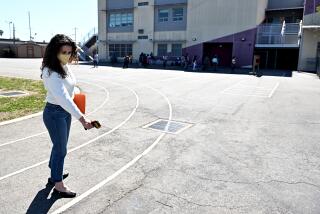City School Buildings in ‘Shameful’ Repair, Report Says
The lack of preventive maintenance and timely repairs has left San Diego city schools in what experts call a “shameful” condition that is detrimental to learning, according to a new comprehensive report on the district’s maintenance program.
Looking at all 179 schools in the San Diego Unified School District, an advisory committee on maintenance found that:
* 135 schools need both interior and exterior paint. For example, Mission Bay High School had not been painted since it opened in 1955 until neighborhood volunteers painted it free last year.
* 127 schools need total asphalt repairs. Although at least 60 sites should be sealed each year, only 53 have been done during the past three years.
* 100 schools need total replacement of window putty, 100 schools need total replacement of asphalt tile, 100 schools need total replacement of irrigation systems and 75 schools need replacement of roofing.
* 100 small boilers in schools more than 25 years old need replacement.
The district would need $49 million over five years for deferred maintenance projects and $4.6 million to carry out other major maintenance projects, the report said in its staccato listing of problems that teachers have routinely complained about for at least a decade. More than 125 schools are at least 25 years old, and vandalism has increased 100% during the last two years, eating up $1 million of the approximate $7-million annual maintenance budget.
In addition, the five-member committee, composed of San Diego-area maintenance and engineering experts, found that the district allocates only 1.4% of its General Fund for repair maintenance, less than half the percentage, 3.1%, of the next lowest allocation among the state’s five largest school districts.
Whether based on dollars per square foot, dollars per student, or as a percent of the General Fund, San Diego’s allocation is among the lowest of all school districts nationwide, the report adds.
The report will be presented to the Board of Education at its meeting today.
“We want to emphasize that the maintenance budget is in desperate need of program enhancements now, “ committee chairman Larry Imrie said, in summarizing the sorry state of the district. Imrie said the committee understands that the school board may have to cut some programs from its 1990-91 budget if state revenue forecasts prove accurate.
But Imrie warned that, despite temptations to cut maintenance in order to maintain academic offerings, “To not consider our recommendations would be a serious error.”
The committee said the district’s present $7.3-million annual budget for overall maintenance should be increased to at least $12.5 million to begin to catch up on maintenance neglected since cutbacks began in 1981. Should San Diego want to match the minimum level in other major California districts, it would need a minimum $16-million maintenance allocation, the committee concluded.
“Before a preventive maintenance program can return the schools to a minimum level of operating efficiency, cleanliness and repair, a substantial capital infusion must be made to correct the damage done through neglect,” said Imrie, facility manager for San Diego Gas & Electric Co.
Another committee member, John L. Harris, division manager for American Building Maintenance Co., said school restrooms are the best example of a lack of preventive maintenance.
“The fixtures are worn out, corroded, rusted or damaged,” Harris wrote. “It’s no wonder that some students don’t show care for school property when the poor appearance of the schools reflects an attitude of not caring on the part of school administration.”
Harris said the carpets in many schools, used especially for reading sessions with elementary students, are “so worn that the seams are taped together, and there are giant water spots from leaky roofs. No amount of cleaning could make this carpet presentable.”
Harris also said custodians lack proper cleaning chemicals and tools for long-lasting maintenance protection.
“Tools and equipment were inadequate for today’s floor finishes,” he said, citing one example. “Most finishes need to be buffed with high-speed machines so the finish is hardened and will last longer. In cases where we found floors being waxed once a year, the question should be asked, ‘Why bother?’ ”
More to Read
Sign up for Essential California
The most important California stories and recommendations in your inbox every morning.
You may occasionally receive promotional content from the Los Angeles Times.










